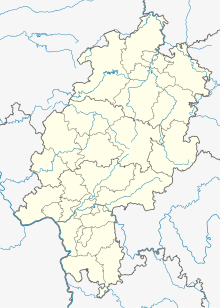Gran (Wolfhagen)
Coordinates: 51 ° 18 ′ 8 ″ N , 9 ° 10 ′ 30 ″ E
Gran was a village settlement in today's district of the North Hessian city Wolfhagen , Kassel district . The place was first mentioned in a document in 1074 and was probably already desolate in 1321 after its residents moved to nearby Wolfhagen.
Geographical location
The place was about 2 km south of Wolfhagen and about 1 km northwest of the Wolfhagen district of Bründersen at 285 m above sea level at the southern foot of the Graner Berg , around which the mill water coming from the east-northeast bends to the northwest. Today the Granfeld homestead group is located around 500 m to the west.
history
Regarding the origin of the settlement, the local historian Gustav Siegel (1861–1931) said in 1929 that there was a settlement of Chatti - Saxon farmers there as early as the end of the 4th century , but it is more likely that the place was only settled in the 8th century.
During the existence of the village, which is documented in writing, the dominant landowners in the village were local aristocrats - the local aristocrats of Gran are from 1150, when Gottschalk von Gran Schultheiss was in Wolfhagen, to 1272, but probably lived at least partially and ultimately only in the vicinity Wolfhagen - and Hasungen Monastery , which was initially founded as a canon monastery in 1074 and which was given property in Gran when it was founded . In 1123, the noble free Riclind / Rilind von Itter , niece and with her sister Frederun, the next heiress of Folkmar von Itter, who died that year, also gave the monastery a church in Gran. Three years later Riclind and Frederun gave the Corvey monastery eight “ iugera ”in Gran, which was assigned to the Marsberg provost. In 1151, the Archbishop of Mainz, Heinrich , confirmed that Trutwin von Gran had given the Hasungen Monastery, among other things, a mill in Gran and property in Fridegossen for a lifelong benefit. In the years 1154 to 1159, Hasungen Monastery acquired another three Hufen in Gran.
In the 13th and early 14th centuries, the St. Petri-Stift in Fritzlar had tithe income in Gran (1209, 1253 and 1310 attested). In 1240 the church in neighboring Todenhausen , which was also donated to Hasungen Monastery in 1124, received seven fields in Gran as a replacement for goods that had been lost elsewhere, and in 1253 the Breitenau Monastery is also mentioned as the owner of property in Gran. Finally, Florentin von Gran, who is proclaimed mayor in Wolfhagen from 1266 to 1268, gave a hoof in Gran in 1272 , which he owned at Meierrecht , to Hasungen Monastery, which then avoided its "curia" in 1311.
It is not known when the village was abandoned and when the last inhabitants moved to Wolfhagen. However, it can be assumed that this already happened before 1321, because in that year the Hasung monastery documents no longer report on the settlement, but only on the Gran Feldmark ("im felde Gran"). Even later mentions refer only to the Feldmark: 1336 Lords of contributed Helfenberg five Mansi in the Feldmark Gran ( "in Campi Gran") the Landgrave Henry II. Of Hessen to feud about, and in 1409 Rudolf refrained from Helfenberg, Burgmann Wolfhagen, u. a. on lands in Gran, which he held as a Hessian fief, in favor of the landgraves.
A pleban is mentioned in Gran for the first time in 1240, later also in 1354, 1389 and 1488. Although the village itself was already in ruins at the beginning of the 14th and certainly the beginning of the 15th century, the church still existed until the Reformation .
Footnotes
- ↑ Georg Landau : Historical-topographical description of the desolate localities in the Electorate of Hesse and in the grand-ducal Hessian parts of Hessengaue, Oberlahngaue and Ittergaue (= journal of the Association for Hessian History and Regional Studies. Supplement 7, ZDB -ID 200295-4 ). Theodor Fischer, Kassel 1858, pp. 170-171 .
- ^ Gustav Siegel: History of the city of Wolfhagen in Hessen . Wolfhagen, 1929, p. 2.
- ↑ One Jugerum = about ¼ hectare.
literature
- Georg Landau : Historical-topographical description of the desolate localities in the Electorate of Hesse and in the grand-ducal Hessian parts of Hessengaue, Oberlahngaue and Ittergaue (= journal of the Association for Hessian History and Regional Studies. Supplement 7, ZDB -ID 200295-4 ). Theodor Fischer, Kassel 1858, pp. 170-171 .
- Heinrich Reimer (Hrsg.): Historical local lexicon for Kurhessen (publications of the historical commission for Hessen). Elwert, Marburg, 1974, p. 180.
- Paul Görlich: Wolfhagen history of a north Hessian city . Historical city history Thiele & Schwarz, Kassel 1980, p. 293-294 .
Web links
- Gran, Kassel district. Historical local dictionary for Hessen. In: Landesgeschichtliches Informationssystem Hessen (LAGIS).
